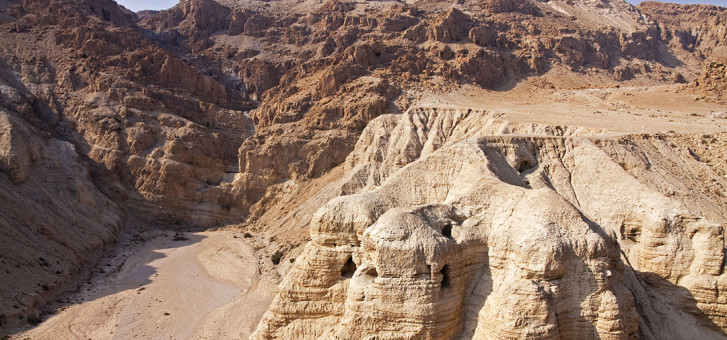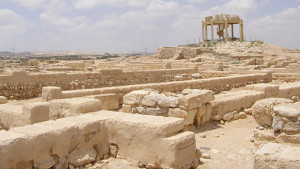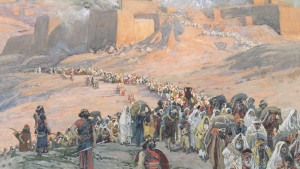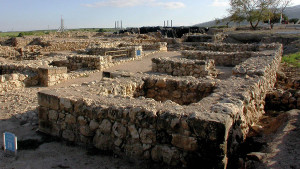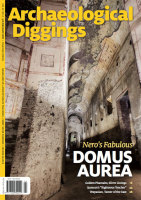As is well known among biblical scholars, it was in the 1946 that a young Bedouin shepherd came across an obscure cave in the wilderness, just to the northwest of the Dead Sea. But humble though it was, this cave would change our knowledge of the Bible and Jewish society during the time of Jesus, forever.
Peering inside this cave, the young shepherd observed a large number of ancient jars that contained a collection of old scrolls. The cave was near Qumran, and its scrolls, as well as other ancient scrolls later found in nearby caves, became known as the Dead Sea Scrolls, written and hidden by the ancient Jewish sect called the Essenes.
The publication of all the scrolls is still only a recent phe- nomenon. Not surprisingly, for years some scholars spread the belief there must have been some sort of conspiracy and cover-up to protect religious institutions from the scrolls’ explosive unpublished content. However, despite the fact that the bulk of the scrolls have now been published, all thus far demonstrating little cause for concern, some still claim that their content undermines the foundations of both Judaism and Christianity. As a result, a theory that Christians might have written the scrolls [not the Essenes] was invented early on. But very quickly, splinter-groups emerged trying to link the scrolls to the early Christians in an effort to gain fame for themselves.
In the early 1980s, one such splinter-group put forward the idea that Jesus’ brother James must have been a great leader in the group at Qumran; and that the scrolls generally, and the Commentary on Habakkuk in particular, should be viewed in light of James’ life and career. Given that James, together with the disciples John and Peter, was a leader of the Christian Church in Jerusalem following Jesus’ death, it was claimed that his influence must have extended to Qumran as well. But at the very same time, another group began to claim that the cryptically labelled “Righteous Teacher” who is mentioned in the Dead Sea Scrolls repeatedly as the religious founder of the group at Qumran, must have actually been John the Baptist, and that the “Wicked Priest,” who the scrolls say was his rival for power, was in fact Jesus.
Then, in the early 1990s, Michael Baigent and Richard Leigh, whose best-selling book The Holy Blood and The Holy Grail inspired Dan Brown to write his now infamous The Da Vinci Code (upon which the blockbuster movie of the same title is based), published The Dead Sea Scrolls Deception. In it, they claimed that the Dead Sea Scrolls were actually written between a.d. 66 and 74, by Christians living in Qumran, and that the similarities between early Christianity and the writers of the Scrolls prove that they must have been one and the same religious group. Therefore baptism was the same ritual cleansing that was practiced at Qumran; and Qumran’s communal sharing, Messianic hopes and the 12 male leaders there all show that the Dead Sea Scrolls had been written by Christians living in Qumran. As for the Righteous Teacher, Baigent and Leigh claimed he must have been Jesus.
This book has had much fame, but was not to be the last splinter-group “theory.” In early 2011, another group actually said that Jesus must have been sent by His parents to be schooled in Qumran by Essene teachers during the lost years from age 13 onwards, and that His textbooks were the actual Dead Sea Scrolls themselves!
These are bold claims, yet of the aforementioned claims fail on three principle counts. First, there is the dating of the Dead Sea Scrolls themselves. Palaeographic testing has proved they were written between the beginning of the second century b.c. and the mid first century a.d.; radio- carbon testing of a scroll’s wrapping in 1951 also resulted in a date toward the beginning of the first century a.d.; and independent radio-carbon testing carried out during the 1990s on eight manuscripts, resulted in dating them all to the first century b.c. Accordingly, there is consensus among most scholars today that the scrolls were written by the Essenes between 200 b.c. and Qumran’s destruction by the Romans in the Great Jewish War in a.d., and just prior to which the Essenes hid them in the caves around Qumran to preserve them from the enemy. As a result, the “Righteous Teacher” could never have been either Jesus or John the Baptist but someone who lived centuries earlier. Renowned Jewish scholar Geza Vermes has actu- ally shown that the Righteous Teacher was originally a priest of some standing in Jerusalem in the early second century b.c., and that after he became despondent with the established priesthood’s moral corruption there, left Jerusalem to found the Essene sect, which, in turn, founded Qumran. This explains his celebrated posterity in the Dead Sea Scrolls (The Complete Dead Sea Scrolls in English, pp. 2, 12–14).
The second count where these wild claims fail is in regards to what the Bible’s Gospels and the Dead Sea Scrolls actually say about Jesus and the Essenes. Of course, the Righteous Teacher had certain qualities, which Bible readers would also observe in Jesus as well: that is, a burning desire to preach salvation, a view of himself as a prophetic figure and a sense that the end times were imminent. But the two had stark differences as well. For one thing, the scrolls never mention Jesus at all. And nor do they ever hint at that Jesus and the Righteous Teacher were one and the same. For another, the Righteous Teacher fled Jerusalem and sought self-preservation in the wilderness near the Dead Sea, whereas Jesus went boldly to Jerusalem, even though He knew He was going to face death by crucifixion there. Closely linked to this is what the Gospels and the Dead Sea Scrolls say about Isaiah’s prophecy that the way of the Messiah would be prepared “in the wilderness” (see Isaiah, 40–44). The Community Rule Dead Sea Scroll says that the whole purpose of the Essene sect’s presence in isolated Qumran was to “prepare the way in the desert” for the Messiah; and they believed this in the hope of fulfilling Isaiah’s prophecy, endearing themselves to God and to the Messiah when He should arrive on the scene (1QS 9.17–22). But this doesn’t prove that Jesus ever lived in Qumran. The idea that the wilderness was the place where God chose to reveal His will to humankind was a long and popular one, and it was one that was widespread in Jesus’ time. In addition, Jesus himself taught that it was not the Essenes of Qumran but John the Baptist, who was baptising and calling people to repentance along the Jordan River who really had prepared the Messiah’s way in the wilderness in accordance with God’s plan.
The third count upon which these sensationalised claims fail is with regard to the finer details of the nature of the actual arguments themselves. They simply lack any historical strength. Baigent and Leigh, for instance, claimed a link between the Essene use of ritual washing and Jesus’ baptism. But ritual washing was practiced throughout the whole Jewish world as Jews ceremonially cleansed themselves to become ritually pure for worship. That was the case at Qumran too. At Qumran itself ritual washing pools called Mikva’ot were built to accommodate this very Jewish practice, and the Scrolls themselves speak of “sprinkling” with “purifying water” (1QS 3.7; Jodi Magness, The Archaeology of Qumran and the Dead Sea Scrolls, pp. 134–162). However, the baptism that John the Baptist and Jesus and his disciples practiced was a once-off immersion not for the purpose of ceremonial purity but as a sign of personal repentance and devotion to God (see Luke 3:3). As for the Essenes’ Messianic hopes, theirs were actually very different to that of Jesus’ own view. Jesus said that He was the one and only Messiah and that we should beware of others claiming to be Him or claiming to possess divine status like Him (see Mark, 13:21). But the Dead Sea Scrolls talk of several expected Essene messiahs (1QS 9.11). Moreover, whereas the Essenes forced their devotees to pool their resources (1QS 1.7), the early Christians voluntarily shared their goods (see Acts of the Apostles 2:44–47). To sum up, despite all claims to the contrary, Jesus was very different to the Righteous Teacher, and the early Christians were very different to the Essenes.
In fact, if anything, to the vast majority of seriousscholars today, as to most people who have read the Dead Sea Scrolls and the Gospels, Jesus was very different to the Righteous Teacher of Qumran, especially in regard to the importance they each placed on love and friendship. The Righteous Teacher taught his followers to keep to the Law of Moses on pain of punishment and death, whereas Jesus preached a message of love, forgiveness and grace. The Righteous Teacher advocated harsh compliance, while Jesus brought to common people the possibility of a loving and understanding relationship with God and with each other.
These markedly different teachings had an effect upon their respective followers. The Essenes became famous for their displays of justified indignation. Josephus wrote that the Essenes “showed indignation when justified” (Josephus, The Jewish War, 2.129). But that was putting it mildly. The Qumran Community Rule scroll actually encouraged its Essene readers to show anger and hatred for all outside their sect (1QS 1.4, 5, 9–11; 4Q258 9.16, 22). In fact, it actually states that all those “chosen” by God (that is, the Essenes) should “hate all that He [God] has rejected” (1QS 1.4, 5), that is, everyone else. But that is not all. The Community Rule stipulated that the Essenes “love all the sons of light, each according to his lot in God’s design,” but “hate all the sons of darkness, each according to his guilt in God’s vengeance” (1QS, 1.9–11). According to the Community Rule, all Essenes were even expected to pledge together “Everlasting hatred in a spirit of secrecy for the men of perdition!” (4Q258 9.22). In fact, at Qumran, the Essenes prided themselves so fiercely on hating outsid- ers that they even composed a War Scroll. This scroll set down guidelines that Essene members were expected to honour when taking on the Romans and the rest of the world in the final eschatological battles between good and evil, light and darkness.
In fact, hatred was so indoctrinated into the Essenes of Qumran that the Community Rule ordered that they were not even allowed to greet or have anything to do with people outside the Essene sect, stating that:
Likewise, no man shall consort with him [an outsider] in regard to his work or property lest he be burdened with the guilt of sin... no member of the community shall follow them in matters of doctrine and justice, or eat or drink anything of theirs, or take anything from them except for a price... For all those not reckoned in His Covenant are to be set apart, together with all that is theirs. (1QS 5.12–18)
Jesus, however, preached a very different message, and he strongly criticised the Essenes for their sanctioned hatred. In fact, it appears that Jesus intentionally sought to correct them and steer people away from the spiteful rules and teachings contained in the Community Rule and the War Scroll. In His Sermon on the Mount, Jesus told his audience:
You have heard that it was said, ‘Love your neighbour and hate your enemy.’ But I tell you: Love your enemies, and pray for those who persecute you, that you may be sons of your Father in heaven. He causes His sun to rise on the evil and the good, and sends rain on the righteous and unrighteous. If you love those who love you, what reward will you get? Are not even the tax collectors doing that? And if you greet only your brothers, what are you doing more than others? Do not even pagans do that? Be perfect, therefore, as your heavenly Father is perfect.” (Matthew 5: 43–48)
Although this is a message for all the ages, it no less applied to Jesus’ own time. Thus, while loving one’s neighbour is a well-known teaching from Leviticus 19:18, hating one’s enemy finds not one mention in the whole of the Old Testament. But as we have seen, it was an Essene doctrine and it was taught in the Dead Sea Scrolls. Therefore, as James H. Charlesworth put it, Jesus probably knew about the Essenes’ doctrine of sanctioned hatred, “abhorred it, and spoke out against it” (Jesus and the Dead Sea Scrolls, p. 24).
We can, therefore, be certain that attempts to link Jesus with Qumran Essenes fall short at every turn, except of course where He actually criticises the rules of the Essenes in the Gospels. The truth is, despite the hopes of conspiracy theorists, there is no evidence anywhere in the ancient sources to suggest that Jesus ever spent any time at Qumran, or even why he should have. Of course, Qumran was one of many Essene communities whose inhabitants Jesus must have come into contact with or heard about. However, he probably never went there himself. That is not to say that the Dead Sea Scrolls have no role to play in the future study of early Christianity. They both emerged out of the same ancient Jewish cultural ferment and milieu. But they progressed in two very different directions from the very beginning with the life of Jesus himself.

